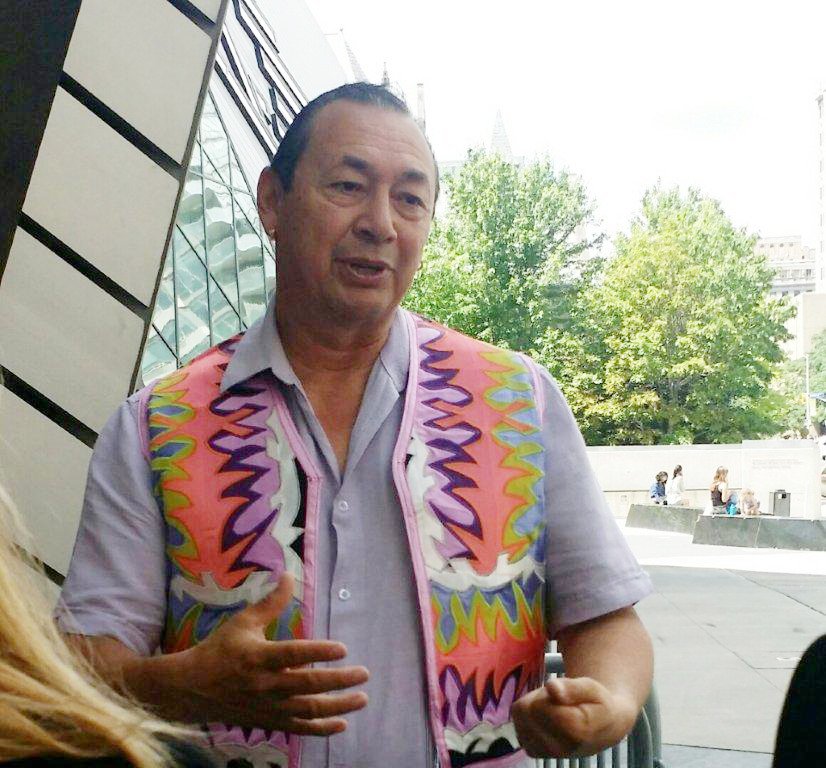By Barb Nahwegahbow
Windspeaker.com Contributor
TORONTO
“These are sacred, living, breathing beings,” said Indigenous educator Amy White as she spoke with the Deputy Director of Collections and Research Mark Engstrom at the Royal Ontario Museum (ROM). They were in a meeting on June 21st about the return of sacred items.
White, from Walpole Island First Nation, spoke about the collection of Indigenous sacred items held by ROM, most of which are stored in vaults.
“This museum is a prison for our sacred items,” White said. “When our sacred institutions were banned, the RCMP and the church stole our sacred items and they ended up here. We know best how to care for our sacred items. That’s our stuff,” she told Engstrom. she told Engstrom.
The meeting was precipitated by an event posted on Facebook by Nicholas Deleary, Three Fires Midewiwin Lodge Pipe Chief. The event, Call to Action at ROM repatriation of sacred items was scheduled for noon.
The Three Fires Lodge is the traditional Anishinaabeg system of spiritual governance. It is also one of the primary sources of Anishinaabeg cultural properties and points of return of sacred items to First Nations communities, Deleary said in his post.
While only a handful of people showed up at ROM in response to Deleary’s call, he achieved his goal when Engstrom came out to invite him and his supporters to meet with him inside.
The Lodge has identified a Pipe that they say belongs to, and descends directly from the Three Fires Lodge. Deleary said he had brought in Elders and knowledge keepers from Canada and the U.S. to examine and identify the Pipe as a means of validating their claim to it. A letter was written to ROM in 2008, Deleary said, and ROM has made no move to return the pipe.
“Some of these items are alive,” Deleary told Engstrom, “but some are just objects. Most moccasins,” he said, “are just objects.”
For many years, Deleary worked on repatriating sacred items from museums including in the U.S.; things that had been identified by Elders as having been stolen from their families. Deleary has been able to locate some items and has been successful in having them returned.
“Emotionally and spiritually, it took a lot out of me,” he said, and he took a break. But his dreams about pipes, in particular, and the need for Indigenous youth to be introduced to the sacred items didn’t let him rest for long.
The Elders who viewed the pipe in question many years ago told Deleary it dates from the 1300s to the 1400s. The Three Fires Confederacy had reformed itself as a spiritual and political governing alliance, he said.
Deleary said the marks on the pipe symbolize the three lodges, three lines are the life roads. There’s a symbol for fire. There’s a Thunderbird or eagle. Wnd there’s an otter. There’s blue and red paint on the pipe, he said, and those colours are significant to the Three Fires.
He said the blackstone for the pipe was likely sourced at a quarry located between Rainy River and Seine River in northern Ontario.
“Our people were traders,” he said.
Deleary took a pipe from his bag that has similar markings and that had been repatriated from a museum several years ago. The pipe was put away for 10 years and was brought out and used at a Three Fires Confederacy gathering in Sault Ste. Marie.
One Elder was brought to tears, he said. This Elder told us, said Deleary, that it was the highlight of his life and that he had waited all his life to see something like this, never thinking he’d actually be able to smoke such a pipe.
“It was incredible to share it with the young people,” said Deleary.
There needs to be a determination of what is sacred and what is appropriate to be in a museum, said White. Bones, for example, she said, don’t belong in a museum.
“What other group has to deal with their graves being dug up?” she said. “Those are our ancestors!”
We are working with different groups around repatriating items, said Engstrom. ROM is in discussions with Rainy River community and he will ask them about the pipe, which has not been part of the conversation. Just because the stone comes from that area doesn’t mean that’s where the pipe originates, Deleary said.
According to Engstrom, ROM has been working with Six Nations of the Grand River to return more than 60 masks to them. The issue in the past, he said, has been lack of resources to deal with repatriation requests.
He hopes they will be more responsive and efficient in future especially since they will be hiring an Indigenous curator in the few months. With regard to the pipe in question, Engstrom said the burden of proof should not be completely on Deleary.
“It’s good to have an Indigenous voice in the institution,” he said, “and we’re moving in that direction. We know we need to change the way we deal with people. I agree we should work together,” he told Deleary.
Engstrom agreed to set up a meeting in the early fall to continue the discussions.
“We don’t want to hold these things hostage forever,” he said.
The delegation presented Engstrom with letters from 32 Indigenous secondary school students asking that the sacred items and ancestral remains be repatriated and the Indigenous people honoured.
According to Amy White, one young woman who wants to be a lawyer wrote that if ROM does not repatriate the items, they are sending the message that they support the continuance of systemic racism and genocide. Nineteen-year-old Chloe White asked Engstrom if he actually planned to read the letters. He said he would not only read the letters, but respond to them as well.
Following the meeting, Deleary said the sacred items in museums, not only ROM, communicate with him through dreams. This is what compels him to bring these items home, back to the people and the communities to which they belong.
They have to be looked after and feasted, he said, and put back into circulation to do their work, to inspire the young people. He did not want to go into detail about his dreams, but he made it clear they are powerful enough to drive his mission to repatriate the items.
They’re not objects, he said.
“These are live, living things. It’s not right for them to be in museums. These pipes, these drums, they want to be touched by our kids, by Anishnaabe hands.”
Deleary felt optimistic about the meeting with ROM. “It’s a good positive sign,” he said.
The issue is lack of resources on the part of the Indigenous community to have their experts and the spiritual leadership travel to meetings. “We’re poor,” he said, “but if you take money from them, these institutions, they still own us.”
Historian Alan Corbiere from M’Chigeeng First Nation and one of the curators of the ROM exhibition, Anishinaabeg: Art & Power agrees that return of sacred items in museums needs to happen.
“But to the right people,” Corbiere said. “Not just to people who make the first claim.”
Engstrom had said earlier that Indigenous people can make appointments to view sacred items in the ROM collection. He also mentioned that admission to ROM is free for Indigenous people and that there isn’t a need to verify Indigenous ancestry through a status card or other documentation.

Nicholas Deleary, Three Fires Midewiwin Lodge Pipe Chief

